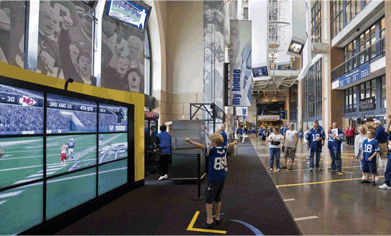The Evolution of Flat Panels is not Taken for Granted
Dimensional Innovations (an Agency of Sprint), working with Wireless Ronin, installed an elaborate digital signage system at Lucas Oil Stadium, the new home for the NFL’s Indianapolis Colts team. The interactive video wall (that features interactive games) consists of nine 46-inch NEC LCD 4620 panels. (Photo courtesy of Wireless Ronin.)
As we arrive and depart from airports, wander around shopping malls, or stop at our favorite convenience centers, we cannot help but be confronted with or, at the very least, exposed to digital signage in one form or another. It fact, all those screens hanging about have become so common and familiar to us that we tend to take them for granted. After all, we have plasma or LCD flat panels in most of our homes for entertainment and our desktops and laptops use LCD screens to display information, so familiarity becomes the end product of all of this exposure.

In a recent newspaper article it was noted that we spend over eight hours of each day in front of one type of screen or another. We have televisions, cell phones, GPS, computers, PDAs, iPods, appliances of every sort, and, of course, digital signage. As consumers, most of us look at all of these displays and think they are all alike with the difference being size and in some cases shape. After all, to the average person a 40-inch flat panel display is a 40-inch flat panel display, and to the uninitiated there is not much new and different.
But if we look beneath the surface of the image on the screen we will see there is a great deal going on in flat panel innovation — in the areas of size, resolution, light output, refresh rates, panel life, image retention, bezel size, and power consumption — that might not be apparent on first look.
- SIZE
- Most of us are familiar with the now standard 40-inch flat panel display. Using the size-matters philosophy that bigger is better, we can now enjoy 50-, 65-, 82-, and up to 108-inch LCD displays. On the plasma side of things, 50-inch displays have become the de facto standard, but 63-, 85-, and 103-inch displays can provide real impact. Although limited in production, you can even buy a 150-inch plasma from the folks at Panasonic. These panels are also getting proportionately thinner and lighter in weight as they get larger.
Sheer image size in a single panel is not enough for some. Videowalls once the domain of cubes with their near zero bezels (but thick cabinets) are facing stiff competition from companies like Samsung and NEC and its 46-inch LCD displays with tiny bezels screen to screen. Not to be outdone, Orion/Saletek and its plasma wall displays have bezels that are 4mm screen to screen. Seeing giant flat screen videowalls is an experience to say the least.
RESOLUTION
Viewers crave that real-life experience in their homes and at the mall. One of the previous disadvantages of flat screen displays has been that if you got close to them you would see pixel structure. We have evolved right past those pixilated displays to the world of HD video and graphics and 1920x1080 resolution. At 8 feet away, the human eye cannot detect the hated screen door effect in a 50- to 60-inch display. We demanded reality and we got it.
Another impediment to viewing is low light output on the part of the display. In a person’s home it is easy to get the room dark and the display’s contrast and brightness to really pop. In the higher ambient light areas where digital signage resides in malls to airports to corporations, it is tough to control the ambient light. The typical light output for a 40-inch LCD flat panel is approximately 400 cd/m2, and it is tough to complete with the environment. The newest Samsung and NEC displays produce up to 700 cd/m2 in their standard large format LCDs, and Samsung even has a model with 1500 cd/m2, Can we say bright? Now we are talking impact.
RESPONSE TIME AND LONGEVITY
One area where we have seen much improvement is the response times of flat panel displays. While perhaps not exciting on the surface, the advantages of faster response times cannot be overstated especially for LCD flat panels. We must note that plasma panels are fast enough and have an advantage over LCD in this area. Not too long ago we saw LCD panels with response times above 16 milliseconds, which parenthetically corresponds to the “speed” of video at 60 Hz refresh rate. The problem with the relatively slow response times is the difficulty of the panel to keep up with video and especially fast action scenes on screen. Fast forward to today and we see response times at 4 milliseconds or less virtually eliminating the video “lag” that was so evident in early flat panel displays. For the casual observer it is now tough to tell the difference between the best plasma and best LCD display when looking at fast action video.

The NEC MultiSync X461UN is an ultra-narrow bezel LCD panel that allows for a screen distance between neighboring displays of only 7.3 mm. The professional-grade LCD panel is 1360x768 resolution with 3000:1 contrast ratio.
Another piece of good news in the story of flat panel evolution is panel life. The average LCD panel life is 60,000 hours to half brightness, and this is with the standard CCFL backlight used for commercial displays. When the commercial LCD products adopt the new LED backlights found in consumer displays, they will last in excess of 100,000 hours. On the plasma side, Panasonic and Samsung both claim 100,000 hours of life out of their products also measured to half brightness. If you do the math with a display used 12 hours per day in a digital signage application, not being especially adept at math, even I can figure out that this is over 20 years of use for a 100K panel.
BURN IN AND POWER CONSUMPTION
One area that has plagued plasma displays and to a certain extent LCD displays is the concept of image retention. In plasma, the effect is actually a “burn-in” of the image on the phosphors of the individual sub pixels. In LCD, image retention or energy retention is a function of heat and the temporary or in extreme cases permanent “warping” of layers in the flat panel itself, keeping the heat and image from dissipating properly. The good news on the plasma side is that with the developments of extreme life rare earth phosphors and advanced anti burn-in technologies, the problem of image retention is dramatically reduced compared to early versions of the technology. On the LCD panels side, companies like Samsung and Toshiba have developed heat sink layers for their panels that dissipate the heat buildup and virtually eliminate the image retention most commonly exhibited in display use beyond 8 hours per day.
One last point of evolution is in the area of power consumption. The newest models of LCD and plasma displays are engineered to provide up to a 30 percent savings in power consumption compared to previous models. Another way to ensure lower power consumption is to calibrate the flat panel display. Tests have shown up to a 20 percent savings in energy on properly calibrated displays versus those that are not.
There you have it, technology evolution personified. Those new flat panel displays that seemingly are everywhere may look the same as previous models from a distance, but in fact they are not. They are built better, perform better, use less power, and last longer. As with all things we tend to take for granted, look beneath the surface and what you find may surprise you.NEC

Alan Brawn (alan@BrawnConsulting.com) is a principal of Brawn Consulting LLC an audiovisual and IT consulting, educational development, and market intelligence firm with national exposure to major manufacturers, distributors, and integrators in the industry. He was formerly president of Telanetix and previously national business development and product marketing director, Samsung Electronics. Brawn is a member of the Imaging Science Foundation and managing director of ISF Commercial. He is CTS certified and an adjunct faculty member of InfoComm sitting on their PETC council and chairing the ISO/ANSI Projected Images Task Group. He is a member of the International Commission on Display Metrology for SID and a Learning Unit provider for NSCA and instructor at CEDIA. Most recently he became director of the Digital Signage Experts Group certifying professionals in the digital signage industry.










